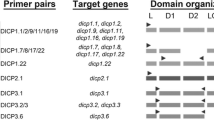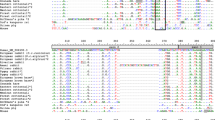Abstract
Chemokines are a family of structurally related chemotactic cytokines that regulate the migration of leukocytes, under both physiological and inflammatory conditions. CC chemokines represent the largest subfamily of chemokines with 28 genes in mammals. Sequence conservation of chemokines between teleost fish and higher vertebrates is low and duplication and divergence may have occurred at a significantly faster rate than in other genes. One feature of CC chemokine genes known to be conserved is genomic clustering. CC chemokines are highly clustered within the genomes of human, mouse, and chicken. To exploit knowledge from comparative genome analysis between catfish and higher vertebrates, here we mapped to bacterial artificial chromosome (BAC) clones 26 previously identified catfish (Ictalurus sp.) chemokine cDNAs. Through a combination of hybridization and fluorescent fingerprinting, 18 fingerprinted contigs were assembled from BACs containing catfish CC chemokine genes. The catfish CC chemokine genes were found to be not only highly clustered in the catfish genome, but also extensively duplicated at various levels. Comparisons of the syntenic relationships of CC chemokines may help to explain the modes of duplication and divergence that resulted in the present repertoire of vertebrate CC chemokines. Here we have also analyzed the expression of the transcripts of the 26 catfish CC chemokines in head kidney and spleen in response to bacterial infection of Edwardsiella ictaluri, an economically devastating catfish pathogen. Such information should pinpoint research efforts on the CC chemokines most likely involved in inflammatory responses.




Similar content being viewed by others
References
Alkhatib G, Combadiere C, Broder CC, Feng Y, Kennedy PE, Murphy PM, Berger EA (1996) CC CKR5: A RANTES, MIP 1a, MIP-1b receptor as a fusion cofactor for macrophage-tropic HIV1. Science 272:1955–1958
Bacon K, Baggiolini M, Broxmeyer H, Horuk R, Lindley I, Mantovani A, Matsushima K, Murphy P, Nomiyama H, Oppenheim J, Rot A, Schall T, Tsang M, Thorpe R, Van Damme J, Wadhwa M, Yoshie O, Zlotnik A, Zoon K (2003) Chemokine/chemokine receptor nomenclature. Cytokine 21:48–49
Bao B, Peatman E, Li P, He C, Liu ZJ (2005) Catfish hepcidin gene is expressed in a wide range of tissues and exhibits tissue-specific upregulation after bacterial infection. Dev Comp Immunol 29:939–950
Bao B, Peatman E, Xu P, Baoprasertkul P, Wang G, Liu Z (2006a) Characterization of 23 CC chemokine genes and analysis of their expression in channel catfish (Ictalurus punctatus). Dev Comp Immunol (in press)
Bao B, Peatman E, Xu P, Li P, Zeng H, He C, Liu ZJ (2006b) The catfish liver-expressed antimicrobial peptide 2 (LEAP-2) gene is expressed in a wide range of tissues and developmentally regulated. Mol Immunol 43:367–377
Baoprasertkul P, He C, Peatman E, Zhang S, Li P, Liu ZJ (2005) Constitutive expression of three novel catfish CXC chemokines: homeostatic chemokines in teleost fish. Mol Immunol 42:1355–1366
Cai WW, Reneker J, Chow CW, Vaishnav M, Bradley A (1998) An anchored framework BAC map of mouse chromosome 11 assembled using multiplex oligonucleotide hybridization. Genomics 54:387–397
Chomczynski P, Sacchi N (1987) Single-step method of RNA isolation by acid guanidinium thiocyanate-phenol-chloroform extraction. Anal Biochem 162:156–159
David NB, Sapede D, Saint-Etienne L, Thisse C, Thisse B, Dambly-Chaudiere C, Rosa FM, Ghysen A (2002) Molecular basis of cell migration in the fish lateral line: role of the chemokine receptor CXCR4 and of its ligand, SDF1. Proc Natl Acad Sci USA 99:16297–16302
Dunham RA, Brady Y, Vinitnantharat S (1993) Response to challenge with Edwardsiella ictaluri by channel catfish, Ictalurus punctatus, selected for resistance to E. ictaluri. J Appl Aquacult 3:211–222
Gonzalez E, Kulkarni H, Bolivar H, Mangano A, Sanchez R, Catano G, Nibbs RJ, Freedman BI, Quinones MP, Bamshad MJ, Murthy KK, Rovin BH, Bradley W, Clark RA, Anderson SA, O’connell RJ, Agan BK, Ahuja SS, Bologna R, Sen L, Dolan MJ, Ahuja SK (2005) The influence of CCL3L1 gene-containing segmental duplications on HIV-1/AIDS susceptibility. Science 307:1434–1440
Han CS, Sutherland RD, Jewett PB, Campbell ML, Meincke LJ, Tesmer JG, Mundt MO, Fawcett JJ, Kim UJ, Deaven LL, Doggett NA (2000) Construction of a BAC contig map of chromosome 16q by two-dimensional overgo hybridization. Genome Res 10:714–721
He C, Peatman E, Baoprasertkul P, Kucuktas H, Liu Z (2004) Multiple CC chemokines in channel catfish and blue catfish as revealed by analysis of expressed sequence tags. Immunogenetics 56:379–387
Jamieson SE, Miller EN, Black GF, Peacock CS, Cordell HJ, Howson JM, Shaw MA, Burgner D, Xu W, Lins-Lainson Z, Shaw JJ, Ramos F, Silveira F, Blackwell JM (2004) Evidence for a cluster of genes on chromosome 17q11-q21 controlling susceptibility to tuberculosis and leprosy in Brazilians. Genes Immun 5:46–57
Julg B, Goebel FD (2005) Susceptibility to HIV/AIDS: an individual characteristic we can measure? Infection 33:160–162
Kumar S, Tamura K, Nei M (2004) MEGA3: Integrated software for Molecular Evolutionary Genetics Analysis and sequence alignment. Brief Bioinform 5:150–163
Laing KJ, Secombes CJ. (2004a) Chemokines. Dev Comp Immunol 28:443–460
Laing KJ, Secombes CJ (2004b) Trout CC chemokines: comparison of their sequences and expression patterns. Mol Immunol 41:793–808
Luo MC, Thomas C, You FM, Hsiao J, Ouyang S, Buell CR, Malandro M, McGuire PE, Anderson OD, Dvorak J (2003) High-throughput fingerprinting of bacterial artificial chromosomes using the SNaPshot labeling kit and sizing of restriction fragments by capillary electrophoresis. Genomics 82:378–389
Modi WS (2004) CCL3L1 and CCL4L1 chemokine genes are located in a segmental duplication at chromosome17q12. Genomics 83:735–738
Molyneaux KA, Zinszner H, Kunwar PS, Schaible K, Stebler J, Sunshine MJ, O’Brien W, Raz E, Littman D, Wylie C, Lehmann R (2003) The chemokine SDF1/CXCL12 and its receptor CXCR4 regulate mouse germ cell migration and survival. Development 130:4279–4286
Moser B, Loetscher P (2001) Lymphocyte traffic control by chemokines. Nat Immunol 2:123–128
Moser B, Wolf M, Walz A, Loetscher P (2004) Chemokines: multiple levels of leukocyte migration control. Trends Immunol 25:75–85
Murphy PM, Baggiolini M, Charo IF, Hebert CA, Horuk R, Matsushima K, Miller LH, Oppenheim JJ, Power CA (2000) International union of pharmacology. XXII. Nomenclature for chemokine receptors. Pharmacol Rev 52:145–176
Neville LF, Mathiak G, Bagasra O (1997) The immunobiology of interferon-gamma inducible protein 10 kD (IP-10): a novel, pleiotropic member of the C-X-C chemokine superfamily. Cytokine Growth Factor Rev 8:207–219
Nibbs RJ, Yang J, Landau NR, Mao JH, Graham GJ (1999) LD78beta, a non-allelic variant of human MIP-1alpha (LD78alpha),has enhanced receptor interactions and potent HIV suppressive activity. J Biol Chem 274:17478–17483
Nomiyama H, Mera A, Ohneda O, Miura R, Suda T, Yoshie O (2001) Organization of the chemokine genes in the human and mouse major clusters of CC and CXC chemokines: diversification between the two species. Genes Immun 2:110–113
Peatman E, Baoprasertkul P, He C, Li P, Kucuktas H, Liu Z (2005) In silico identification and expression analysis of 12 novel CC chemokines in catfish. Immunogenetics 57: 409–419
Ross MT, LaBrie S, McPherson J, Stanton VP (1999) Screening large-insert libraries by hybridization. In: Boyl A (ed) Current protocols in human genetics. Wiley, New York, pp 5.6.1–5.6.52
Saitou N, Nei M (1987) The neighbor-joining method: a new method for reconstructing phylogenetic trees. Mol Biol Evol 4:406–425
Sambrook J, Frisch EF, Maniatis T (1989) Molecular cloning: a laboratory manual. Cold Spring Harbor Laboratory Press, Cold Spring Harbor
Soderlund C, Longden I, Mott R (1997) FPC: a system for building contigs from restriction fingerprinted clones. Comput Appl Biosci 13:523–535
Soderlund C, Humphray S, Dunham A, French L (2000) Contigs built with fingerprints, markers, and FPC V4.7. Genome Res 10:1772–1787
Sulston et al (1988) Software for genome mapping by fingerprint techniques. Comput Appl Biosci 4:125–132
Sulston J, Mallett F, Durbin R, Horsnell T (1989) Image analysis of restriction enzyme fingerprint autoradiograms. Comput Appl Biosci 5:101–106
Thompson JD, Higgins DG, Gibson TJ (1994) ClustalW: Improving the sensitivity of progressive multiple sequence alignment through sequence weighting, position-specific gap penalties and weight matrix choice. Nucleic Acids Res 22: 4673–4680
Townson JR, Barcellos LF, Nibbs RJ (2002) Gene copy number regulates the production of the human chemokine CCL3-L1. Eur J Immunol 32:3016–3026
Wang J, Adelson DL, Yilmaz A, Sze SH, Jin Y, Zhu JJ (2005) Genomic organization, annotation, and ligand-receptor inferences of chicken chemokines and chemokine receptor genes based on comparative genomics. BMC Genomics 6:45
Xu P, Bao B, Zhang S, Peatman E, He C, Liu ZJ (2005) Characterization and expression analysis of bactericidal permeability-increasing protein (BPI) antimicrobial peptide gene from channel catfish Ictalurus punctatus. Dev Comp Immunol 29:865–878
You FM, Luo MC (2003) GenoProfiler user’s manual. http://wheat.pw.usda.gov/PhysicalMapping/tools/genoprofiler/manual/
Acknowledgements
This project was supported by a grant from USDA NRI Animal Genome Basic Genome Reagents and Tools Program (USDA/NRICGP 2003-35205-12827), in part by E-Institute of Shanghai Municipal Education Commission, Project number E03009, and in part by a Specific Cooperative Agreement with USDA ARS Aquatic Animal Health Laboratory under the Contract Number 58-6420-5-030. We thank Renee Beam, Karen Veverica, Esau Arana, and Randell Goodman for their excellence in the production and maintenance of fish used in this study and their assistance during challenge experiments.
Author information
Authors and Affiliations
Corresponding author
Additional information
Communicated by S. Hohmann
Eric Peatman and Baolong Bao contributed equally
Rights and permissions
About this article
Cite this article
Peatman, E., Bao, B., Peng, X. et al. Catfish CC chemokines: genomic clustering, duplications, and expression after bacterial infection with Edwardsiella ictaluri . Mol Genet Genomics 275, 297–309 (2006). https://doi.org/10.1007/s00438-005-0081-9
Received:
Accepted:
Published:
Issue Date:
DOI: https://doi.org/10.1007/s00438-005-0081-9




